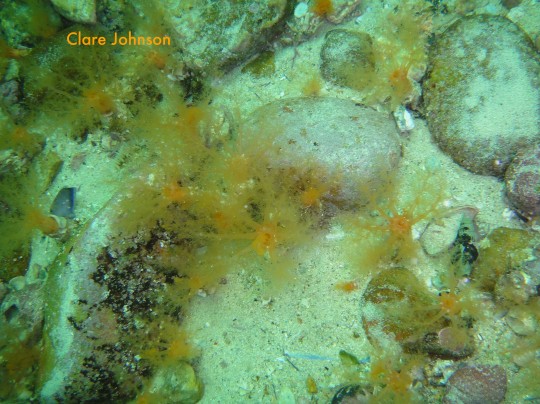
Sea cucumbers often feature at the Touch Pool at the Two Oceans Aquarium, and the kids are delighted by their squishyness. They are related to sea urchins and sea anemones. Like them, sea cucumbers are radially symmetric – they have rows of little tube feet running up their bodies, and at one end of their bodies, a circular array of tentacles around their mouths that they use to capture food.

They are found either partially buried in the sand, or congregated in huge groups on shipwrecks such as the Clan Stuart and the Romelia. Many of the deep wrecks in Cape Town are covered with mauve sea cucumbers (mauve being an optimistic designation – they are grey!) and Stephenson’s sea cucumbers (which are red).

My personal preference (if you care) is for the golden sea cucumbers who bury themselves in the sand – they are much prettier when they hide the sluggish part of their bodies! Their tentacles fan out like little trees on the sea floor, and I think they’re delicate and beautiful. You can see that the bodies of some of them in the picture above have been exposed a little by the sand washing away from their bases.

The other species of sea cucumber that buries itself in the sand is the horseshoe sea cucumber. I’ve found some really gorgeous examples at Long Beach. They often look far too pretty and dramatic to be something as commonplace as an underwater slug!

Some species of sea cucumbers have highly toxic flesh – they are the bane of aquarists, able to wipe out an entire tank of fish with an expulsion of a toxic chemical called holuthurin if they die or get stresssed. Others expel their guts when they get upset, as a defensive mechanism. These creatures have incredibly flexible bodies; they are able to loosen the collagen fibres that hold the shape of their bodies, squeeze through ridiculously small gaps (essentially pouring themselves through), and then reconstitute themselves to look the way they did before by tightening all the collagen fibres again.

They are generally scavengers, eating whatever debris they can find to digest on the sea floor. Some will also eat plankton as it drifts past their tentacles. As far as being eaten goes, sea cucumbers are considered a great delicacy in some parts of the world (they’re known as trepang or bêche-de-mer) and are harvested and dried before being used in stir fries.

Apparently in the ocean depths (deeper than 9 kilometres), sea cucumbers make up over 90% of the biomass of the macrofauna. Even though the Titanic lies at only (!) 4 kilometres’ depth, most of the marine life observed around it was sea cucumbers. When you see a photo like the one above, taken at 25 metres in the Atlantic on a dive we did on the Cape Matapan, you can believe it.









One thought on “Sea life: Sea cucumbers”
Comments are closed.